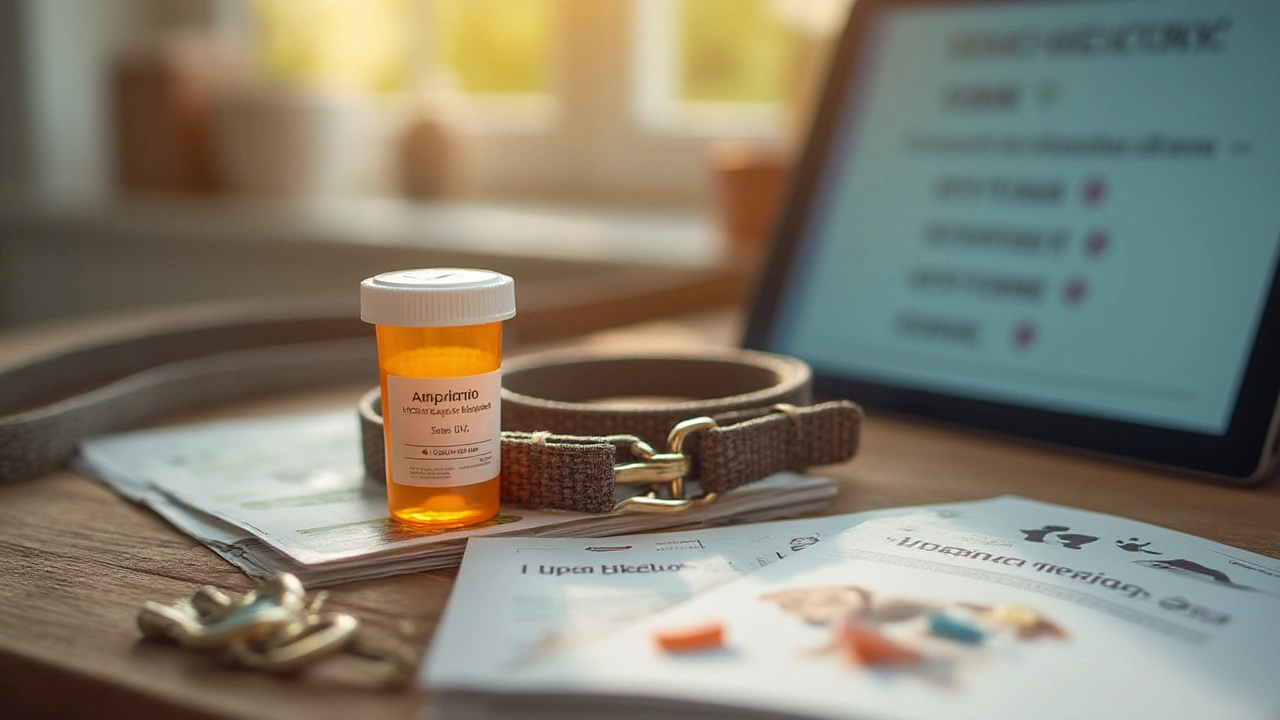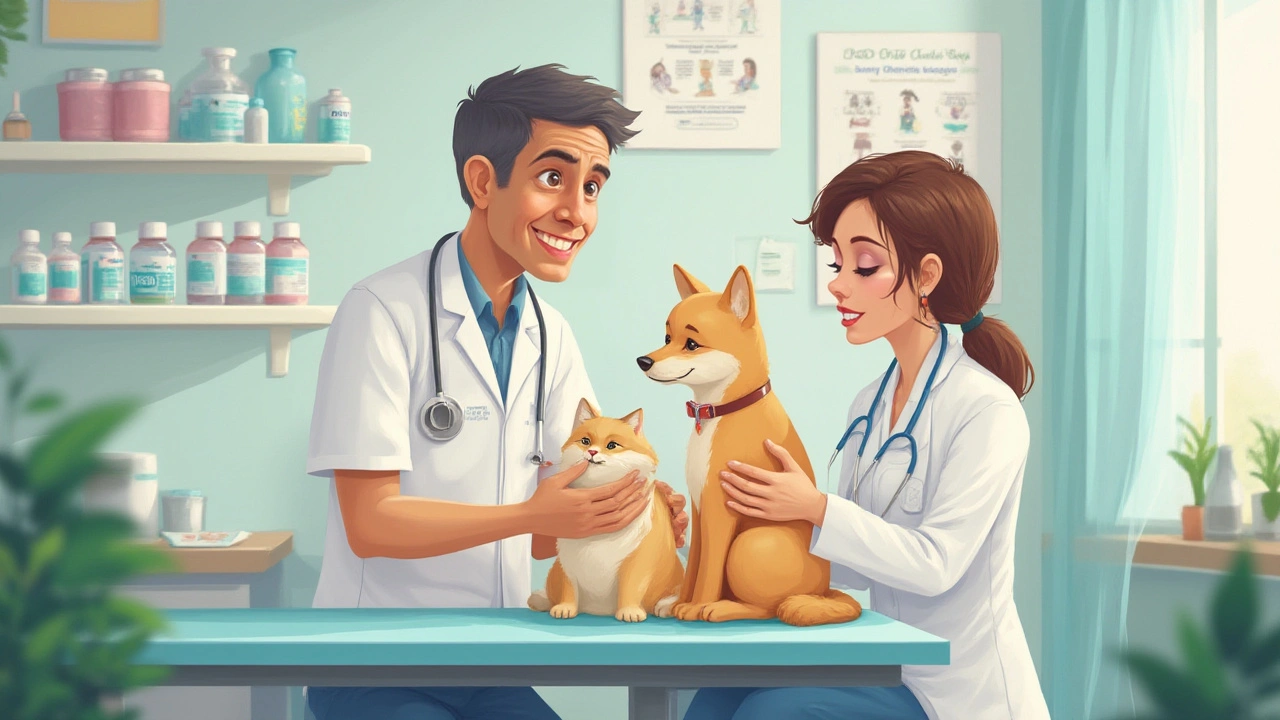Picture this: your dog suddenly won’t eat, or your cat’s been hiding and clearly isn’t their usual cheeky self. When a pet gets sick, the clock seems to tick louder and faster. One word that pops up at the vet more often than most is ampicillin. It isn’t a new kid on the block—ampicillin’s been used in both human and veterinary medicine since the 1960s. But how it works in our furry companions, and what you should expect if your vet prescribes it, isn’t common knowledge for most pet owners.
Ampicillin: What It Is and How It Works in Pets
Ampicillin is part of the penicillin family, a type of beta-lactam antibiotic. It's specifically good at fighting off a lot of the bacteria that cause everyday infections in dogs and cats. Vet clinics frequently reach for ampicillin to tackle respiratory tract infections, urinary tract infections, soft tissue infections, and even some cases of sepsis. Its broad spectrum action means it knocks out both gram-positive and gram-negative bacteria—but it doesn’t touch everything. Some bacteria have learned to resist its punch, which is why resistance testing and smart antibiotic use matter now more than ever.
If your vet brings up ampicillin, they're probably focusing on bacterial—not viral—culprits. In urinary tract infections, for example, ampicillin is often a great first-line pick, especially for E. coli or Staphylococcus species. Skin wounds that look red, oozy, or smell are other classic use cases. It’s prescribed either as an injection or pills, sometimes liquid for cats who'd rather spit a tablet halfway across the kitchen.
It works by breaking open the bacterial cell wall, like popping a water balloon. No wall, no bug—simple as that. What makes ampicillin stand out among antibiotics is that, compared to some newer drugs, it's less likely to build up in a pet’s body or hit organs like the kidneys or liver too hard. That said, your vet won’t just hand it out “just in case.” Because bacteria are clever and can learn to dodge even good old ampicillin, vets are extra careful to test and only use it when it’s a sure winner.
If your vet thinks ampicillin is a good fit, they may send a sample for culture and sensitivity. That means checking which bacteria are causing trouble and seeing which antibiotics can beat them. That way, you’re not just trying random meds—you’re picking the champion for that specific infection. This is even more important now, with superbugs on the rise in both humans and animals.
Another crucial thing—if your pet’s got a history of penicillin allergies, your vet will steer clear of ampicillin altogether. Allergies can show up as mild rashes, swelling, or, in serious cases, trouble breathing. Always tell your vet if your pet’s had any weird reactions to antibiotics in the past.
How Vets Decide the Right Dose: Dosing and Administration Tips
Dosing ampicillin isn’t one-size-fits-all. Vets take your pet’s weight, age, condition, and how sick they are into account before picking a dose. For dogs, the standard dose usually falls between 10-20 mg per kilogram, given every 8 to 12 hours. Cats tend to need similar dosing by weight, but their stubbornness can make dosing more creative—crushing pills into food, using flavored liquids, or giving injections if needed. Puppy or kitten? The vet might adjust the dose lower because their kidneys and livers are still learning the ropes of processing meds.
Here’s a table showing typical dosing for common pet sizes:
| Pet Type | Weight | Usual Dose (mg) | Frequency | Route |
|---|---|---|---|---|
| Dog | 10 kg | 100-200 mg | Every 8-12 hours | Oral/Injection |
| Cat | 5 kg | 50-100 mg | Every 8-12 hours | Oral/Injection |
| Dog | 25 kg | 250-500 mg | Every 8-12 hours | Oral/Injection |
The timing is more important than you’d think. Missing a dose or being inconsistent can let the infection bounce back stronger. That’s why vets say finish every course, even if the pet seems “all better” halfway through. Leftover bacteria get “smarter” if they survive half a treatment—and nobody wants that.
If your cat spits out the pill, don’t just skip and hope for the best. Ask your vet about liquid options, pill pockets, or even an injection that covers a few days at once. And stash antibiotics out of reach—a lot of dogs eat anything that smells interesting, and overdosing is a risk if they get into the bottle.
Be mindful about other meds. Ampicillin can interact with drugs like allopurinol (used for certain types of bladder stones) or aminoglycosides (another type of antibiotic), so tell your vet about anything else your pet gets, including supplements or “natural” remedies.
Hydration is your best friend while treating with antibiotics. Make sure your dog or cat always has fresh water, as antibiotics are filtered through kidneys and a well-hydrated pet bounces back quicker.

Safety and Side Effects of Ampicillin for Dogs and Cats
Most pets do just fine on ampicillin, especially if the dose is spot-on and you stick to the schedule. But, as with any med, side effects can show up. The most common complaints are mild stomach upset—think vomiting, diarrhea, or a pet going off their food for a day or two. More rarely, you could see signs of an allergic reaction: facial swelling, hives, or trouble breathing. If any of those pop up, stop the drug straight away and call a vet.
Some pets can have loose stools that last for a day or two at the start. Usually, it settles as their system gets used to the drug. Feeding with meals often helps buffer the gut, and splitting doses (morning and night) can mean less tummy trouble. But if your pet gets very sick—lots of vomiting, refusal to eat for more than 24 hours, or bloody diarrhea—get them seen fast. In small breeds or kittens, dehydration happens quickly.
Cats, in particular, can be sensitive to bitterness in meds, so if yours starts drooling excessively or refusing all food, mention it to your vet. They may switch the form or offer anti-nausea help to keep the antibiotic plan on track.
The risk of antibiotic resistance is always present when antibiotics are overused or misused. That’s why your vet might push back if you ask for antibiotics “just in case” for minor issues. Bacteria living in or around your pet are clever—the less we mess around, the longer these drugs will work for everyone: pets and people, alike.
If you’re curious about the specifics or want a deeper dive on possible reactions, check out this detailed resource on Ampicillin side effects in dogs. Real-world case studies and lists make it a handy reference if you have questions midway through treatment.
Antibiotics like ampicillin can sometimes mess with your pet’s gut bacteria—so don’t be shocked if your vet recommends a probiotic alongside the medication. It keeps things balanced, especially if your dog loves to scavenge and has a sensitive system. Ask what over-the-counter options are right for your particular breed or age group.
Older animals or those with kidney or liver problems might need extra monitoring. Your vet could suggest a blood test before and after a course of ampicillin to check organ function, particularly if your pet is already on long-term meds for chronic issues like arthritis or heart problems. It’s less about the risk and more about playing it safe from the start.
If an injection is given and there’s swelling, pain, or your pet limps afterward, mention it at the next check. Rare, but possible.
Practical Tips For Pet Owners: Making Antibiotic Courses Easier
No one likes playing bad cop with their pets. Giving tablets can feel like a full-contact sport, especially if you’ve got a stubborn terrier or a suspicious tabby. One trick: wrap pills in a bit of chicken, cheese, or a soft treat. For cats, some owners find tuna water or lickable treats work as disguises. Liquid forms can be squirted along the cheek pouch—not the back of the throat, or it might all come flying out. If you’ve never done it, ask your vet to show you a safe hold so both you and your pet stay calm (and scratch-free).
Always store antibiotics in the original container, away from heat and sunlight. Double check expiry dates, and never reuse leftover meds “just in case” a similar illness pops up in the future. Each infection can behave differently, and bacteria that survive incomplete or old treatment get harder to kill next time.
If you’re ever running late on a dose, don’t double up—just give the next one as soon as you remember or at the next scheduled time. Watch for any changes in your pet’s bathroom habits, eating, or behavior over the next 48 hours. A journal, even a quick note on your phone, helps track patterns and spot issues sooner.
Don’t skip the follow-up unless your vet says it’s okay. Infections can hide, and sometimes symptoms clear before the problem’s really fixed. Your vet might want to run another urine test or a blood panel to make sure the bugs are gone for good.
If you’re worried about cost, ask about generics or pill-splitting (if safe for your pet’s dose). Many practices can work out an affordable plan without cutting corners on care quality.
And if your pet needs regular antibiotics for chronic conditions, try to keep their vaccines up to date and avoid high-risk environments (like crowded kennels or animal parks when there are local outbreaks). That way, you help reduce the chance of needing antibiotics in the first place.
Ampicillin remains a trusted, vet-approved frontline defense against a host of common infections—for both dogs and cats. While new meds keep showing up, the tried-and-true drugs stick around because they work. The key? Use them smartly, follow your vet’s plans, watch for changes, and don’t be afraid to ask questions or get support. Your pet might not know why you’re stuffing a tablet in their cheese, but you’re helping them bounce back stronger—and probably saving yourself a night at the emergency clinic down the road.
